Project Management and Transportation - Transport for London
VerifiedAdded on 2023/06/18
|14
|2494
|379
AI Summary
This report includes methodologies, network diagram analysis of stakeholders, WBS and analyzing risks in order to improve the productivity for the business. The project is about creating a land along Bollo Lane with the purpose to make more than 800 new homes in Acton.
Contribute Materials
Your contribution can guide someone’s learning journey. Share your
documents today.
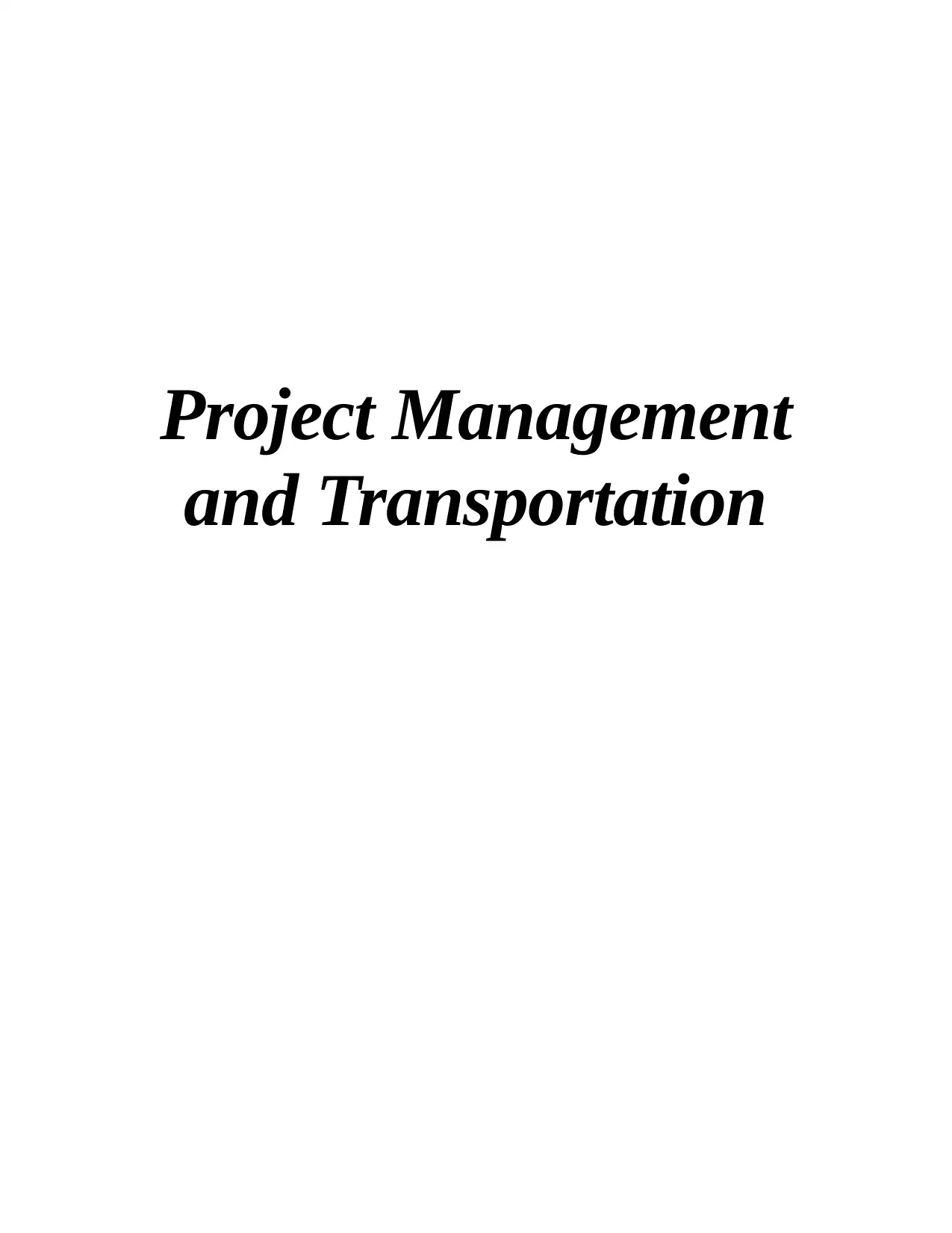
Project Management
and Transportation
and Transportation
Secure Best Marks with AI Grader
Need help grading? Try our AI Grader for instant feedback on your assignments.

Table of Contents
INTRODUCTION...........................................................................................................................................3
TASK 1..........................................................................................................................................................3
Methodologies.........................................................................................................................................3
TASK 2..........................................................................................................................................................4
Network diagram.....................................................................................................................................4
TASK 3..........................................................................................................................................................8
Stakeholder analysis................................................................................................................................8
TASK 4..........................................................................................................................................................9
Work break-down structure (WBS)..........................................................................................................9
TASK 5........................................................................................................................................................10
Risk Analysis...........................................................................................................................................10
TASK 6........................................................................................................................................................12
CONCLUSION.............................................................................................................................................13
REFERENCES..............................................................................................................................................14
Books and journals:...............................................................................................................................14
INTRODUCTION...........................................................................................................................................3
TASK 1..........................................................................................................................................................3
Methodologies.........................................................................................................................................3
TASK 2..........................................................................................................................................................4
Network diagram.....................................................................................................................................4
TASK 3..........................................................................................................................................................8
Stakeholder analysis................................................................................................................................8
TASK 4..........................................................................................................................................................9
Work break-down structure (WBS)..........................................................................................................9
TASK 5........................................................................................................................................................10
Risk Analysis...........................................................................................................................................10
TASK 6........................................................................................................................................................12
CONCLUSION.............................................................................................................................................13
REFERENCES..............................................................................................................................................14
Books and journals:...............................................................................................................................14

INTRODUCTION
Project management refers to a process of leading the team work to accomplish goals of
all projects within the certain constraints. In other words, it is all about particular skills,
knowledge, techniques and tools to provide something of value to individuals. All projects are
including temporary effort to generate value through unique result, service or a product. All
projects have a budget, team, a set of expectations, and a schedule (Brewer and Dittman, 2018).
Each and every project is differ and unique from regular operations, because project attain a
summarization once the objective is achieved. For example, the software development for an
enhanced process of business, the relief effort after a natural disaster, the construction of a
building or expansion of sales into a new geographic location. The report is preparing on the
project "Transport for London" (TFL). This project is all about creating a land along Bollo Lane
with the purpose to make more than 800 new homes in Acton. TFL facilitates fund for an event
planned for the celebration of 40th anniversary of G&S society. This report includes
methodologies, network diagram analysis of stakeholders, WBS and analyzing risks in order to
improve the productivity for the business.
TASK 1
Methodologies
TFL is all about creating more than 800 new homes in Acton. The aim of TFL is to
undertake road projects to develop greener, safer and more attractive streets as well as an uncut
bus network throughout London. A project plan includes a documentation of work, list of
resources, work breakdown structure, a schedule for project as well as a risk plan. The scope
consists the requirements of business and its problem, goals of project, deliverables as well as
main milestones. A project management methodology is a combination of practices and
principles that leads in organizing projects to make sure the maximum performance. There are
different methodologies linked with project management. Some of them are as follows:
Waterfall: This kind of methodology is a classical approach to a project management in
which phases and tasks are completed in a sequential and linear manner and each step of the
project must be done before next step begins. It includes stages such as requirements, analysis,
design, construction, testing, deployment and maintenance. These stages progress in a single
direction like an actual waterfall. The requirement stage is used by Transport for London to
examine the requirements of product while making projects, software architecture is exploited in
project designing as well as implement accordingly in order to handle each functions (Copola
Azenha, Aparecida Reis and Leme Fleury, 2021). In the testing stage, raw materials and products
are tested while making homes. The last stage is the development and maintenance which is used
to maintain each project and tasks in an effective way. This will assist the company to generate
profitability and productivity for the organization by following each and every step.
Pros: Testing is made easy: Scenarios for test are already explained in the functional
specification of the requirement stage, which makes testing transparent and easier.
Project management refers to a process of leading the team work to accomplish goals of
all projects within the certain constraints. In other words, it is all about particular skills,
knowledge, techniques and tools to provide something of value to individuals. All projects are
including temporary effort to generate value through unique result, service or a product. All
projects have a budget, team, a set of expectations, and a schedule (Brewer and Dittman, 2018).
Each and every project is differ and unique from regular operations, because project attain a
summarization once the objective is achieved. For example, the software development for an
enhanced process of business, the relief effort after a natural disaster, the construction of a
building or expansion of sales into a new geographic location. The report is preparing on the
project "Transport for London" (TFL). This project is all about creating a land along Bollo Lane
with the purpose to make more than 800 new homes in Acton. TFL facilitates fund for an event
planned for the celebration of 40th anniversary of G&S society. This report includes
methodologies, network diagram analysis of stakeholders, WBS and analyzing risks in order to
improve the productivity for the business.
TASK 1
Methodologies
TFL is all about creating more than 800 new homes in Acton. The aim of TFL is to
undertake road projects to develop greener, safer and more attractive streets as well as an uncut
bus network throughout London. A project plan includes a documentation of work, list of
resources, work breakdown structure, a schedule for project as well as a risk plan. The scope
consists the requirements of business and its problem, goals of project, deliverables as well as
main milestones. A project management methodology is a combination of practices and
principles that leads in organizing projects to make sure the maximum performance. There are
different methodologies linked with project management. Some of them are as follows:
Waterfall: This kind of methodology is a classical approach to a project management in
which phases and tasks are completed in a sequential and linear manner and each step of the
project must be done before next step begins. It includes stages such as requirements, analysis,
design, construction, testing, deployment and maintenance. These stages progress in a single
direction like an actual waterfall. The requirement stage is used by Transport for London to
examine the requirements of product while making projects, software architecture is exploited in
project designing as well as implement accordingly in order to handle each functions (Copola
Azenha, Aparecida Reis and Leme Fleury, 2021). In the testing stage, raw materials and products
are tested while making homes. The last stage is the development and maintenance which is used
to maintain each project and tasks in an effective way. This will assist the company to generate
profitability and productivity for the organization by following each and every step.
Pros: Testing is made easy: Scenarios for test are already explained in the functional
specification of the requirement stage, which makes testing transparent and easier.
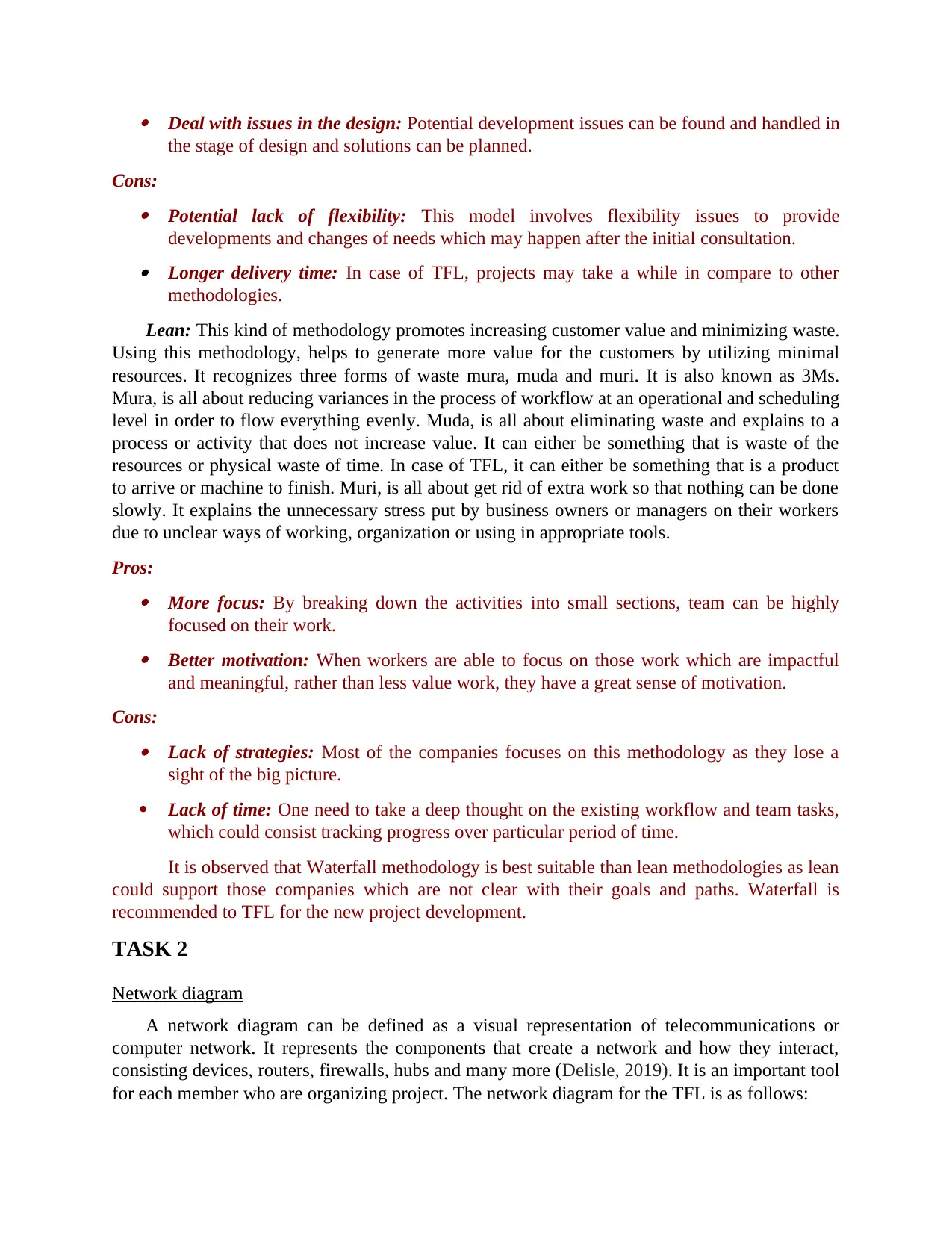
Deal with issues in the design: Potential development issues can be found and handled in
the stage of design and solutions can be planned.
Cons: Potential lack of flexibility: This model involves flexibility issues to provide
developments and changes of needs which may happen after the initial consultation. Longer delivery time: In case of TFL, projects may take a while in compare to other
methodologies.
Lean: This kind of methodology promotes increasing customer value and minimizing waste.
Using this methodology, helps to generate more value for the customers by utilizing minimal
resources. It recognizes three forms of waste mura, muda and muri. It is also known as 3Ms.
Mura, is all about reducing variances in the process of workflow at an operational and scheduling
level in order to flow everything evenly. Muda, is all about eliminating waste and explains to a
process or activity that does not increase value. It can either be something that is waste of the
resources or physical waste of time. In case of TFL, it can either be something that is a product
to arrive or machine to finish. Muri, is all about get rid of extra work so that nothing can be done
slowly. It explains the unnecessary stress put by business owners or managers on their workers
due to unclear ways of working, organization or using in appropriate tools.
Pros: More focus: By breaking down the activities into small sections, team can be highly
focused on their work. Better motivation: When workers are able to focus on those work which are impactful
and meaningful, rather than less value work, they have a great sense of motivation.
Cons: Lack of strategies: Most of the companies focuses on this methodology as they lose a
sight of the big picture.
Lack of time: One need to take a deep thought on the existing workflow and team tasks,
which could consist tracking progress over particular period of time.
It is observed that Waterfall methodology is best suitable than lean methodologies as lean
could support those companies which are not clear with their goals and paths. Waterfall is
recommended to TFL for the new project development.
TASK 2
Network diagram
A network diagram can be defined as a visual representation of telecommunications or
computer network. It represents the components that create a network and how they interact,
consisting devices, routers, firewalls, hubs and many more (Delisle, 2019). It is an important tool
for each member who are organizing project. The network diagram for the TFL is as follows:
the stage of design and solutions can be planned.
Cons: Potential lack of flexibility: This model involves flexibility issues to provide
developments and changes of needs which may happen after the initial consultation. Longer delivery time: In case of TFL, projects may take a while in compare to other
methodologies.
Lean: This kind of methodology promotes increasing customer value and minimizing waste.
Using this methodology, helps to generate more value for the customers by utilizing minimal
resources. It recognizes three forms of waste mura, muda and muri. It is also known as 3Ms.
Mura, is all about reducing variances in the process of workflow at an operational and scheduling
level in order to flow everything evenly. Muda, is all about eliminating waste and explains to a
process or activity that does not increase value. It can either be something that is waste of the
resources or physical waste of time. In case of TFL, it can either be something that is a product
to arrive or machine to finish. Muri, is all about get rid of extra work so that nothing can be done
slowly. It explains the unnecessary stress put by business owners or managers on their workers
due to unclear ways of working, organization or using in appropriate tools.
Pros: More focus: By breaking down the activities into small sections, team can be highly
focused on their work. Better motivation: When workers are able to focus on those work which are impactful
and meaningful, rather than less value work, they have a great sense of motivation.
Cons: Lack of strategies: Most of the companies focuses on this methodology as they lose a
sight of the big picture.
Lack of time: One need to take a deep thought on the existing workflow and team tasks,
which could consist tracking progress over particular period of time.
It is observed that Waterfall methodology is best suitable than lean methodologies as lean
could support those companies which are not clear with their goals and paths. Waterfall is
recommended to TFL for the new project development.
TASK 2
Network diagram
A network diagram can be defined as a visual representation of telecommunications or
computer network. It represents the components that create a network and how they interact,
consisting devices, routers, firewalls, hubs and many more (Delisle, 2019). It is an important tool
for each member who are organizing project. The network diagram for the TFL is as follows:
Secure Best Marks with AI Grader
Need help grading? Try our AI Grader for instant feedback on your assignments.
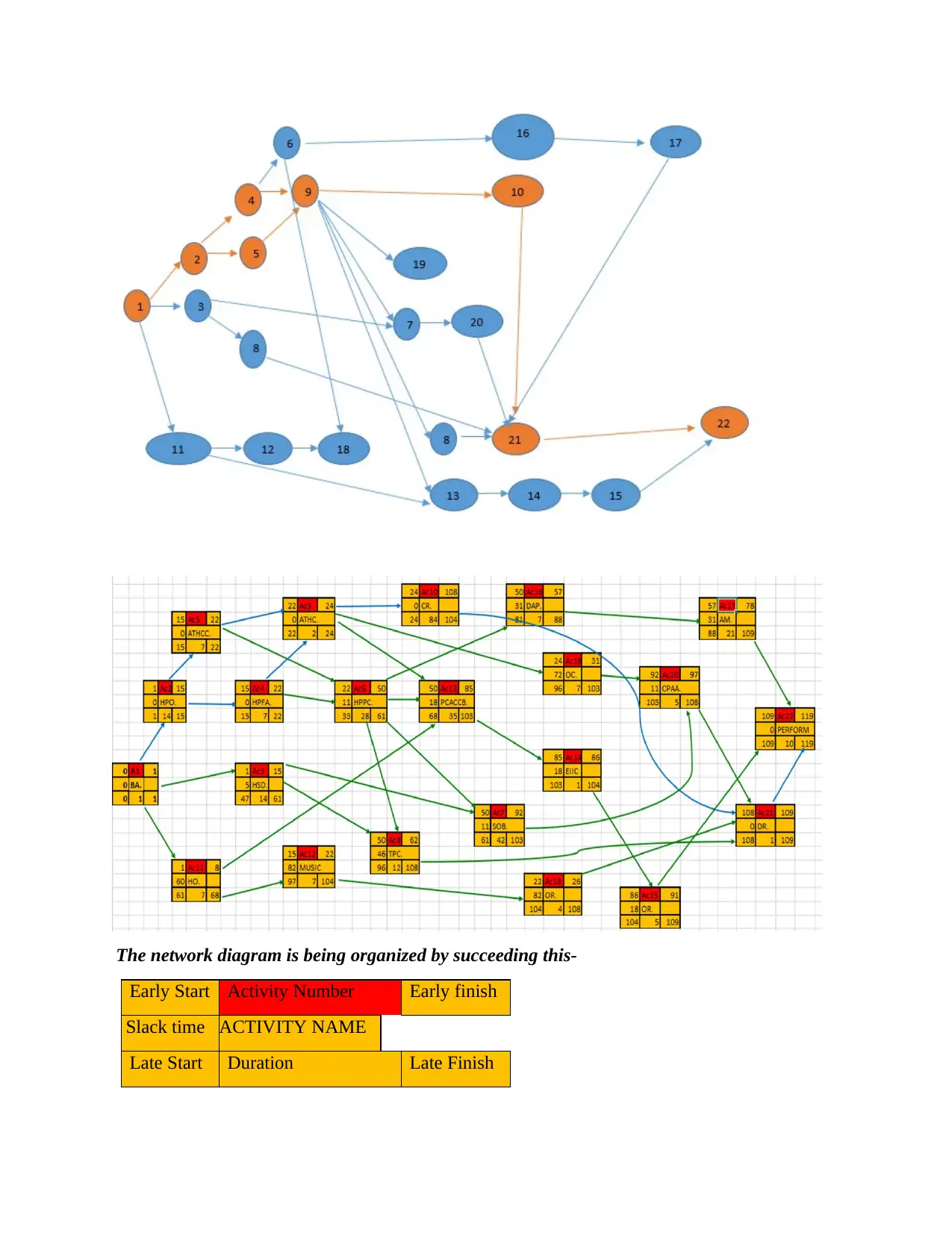
The network diagram is being organized by succeeding this-
Early Start Activity Number Early finish
Slack time ACTIVITY NAME
Late Start Duration Late Finish
Early Start Activity Number Early finish
Slack time ACTIVITY NAME
Late Start Duration Late Finish

With the help of critical path, it is examined that how much time will be taken for the project
completion. According to this evaluation, maximum time taken for the completion is more than
one week. According to this diagram, the maximum possible time taken activities are
1,2,4,5,9,10,21 and 22. Therefore, the current project will be done in 116 days.
Gantt Chart:
It is a useful tool in project management that assists all size of projects in their planning
and scheduling, although they are helpful in simplifying complicated projects. In case of TFL, it
will assist how existing project should take time, determining the required resources and an
effective plan to complete the project.
completion. According to this evaluation, maximum time taken for the completion is more than
one week. According to this diagram, the maximum possible time taken activities are
1,2,4,5,9,10,21 and 22. Therefore, the current project will be done in 116 days.
Gantt Chart:
It is a useful tool in project management that assists all size of projects in their planning
and scheduling, although they are helpful in simplifying complicated projects. In case of TFL, it
will assist how existing project should take time, determining the required resources and an
effective plan to complete the project.
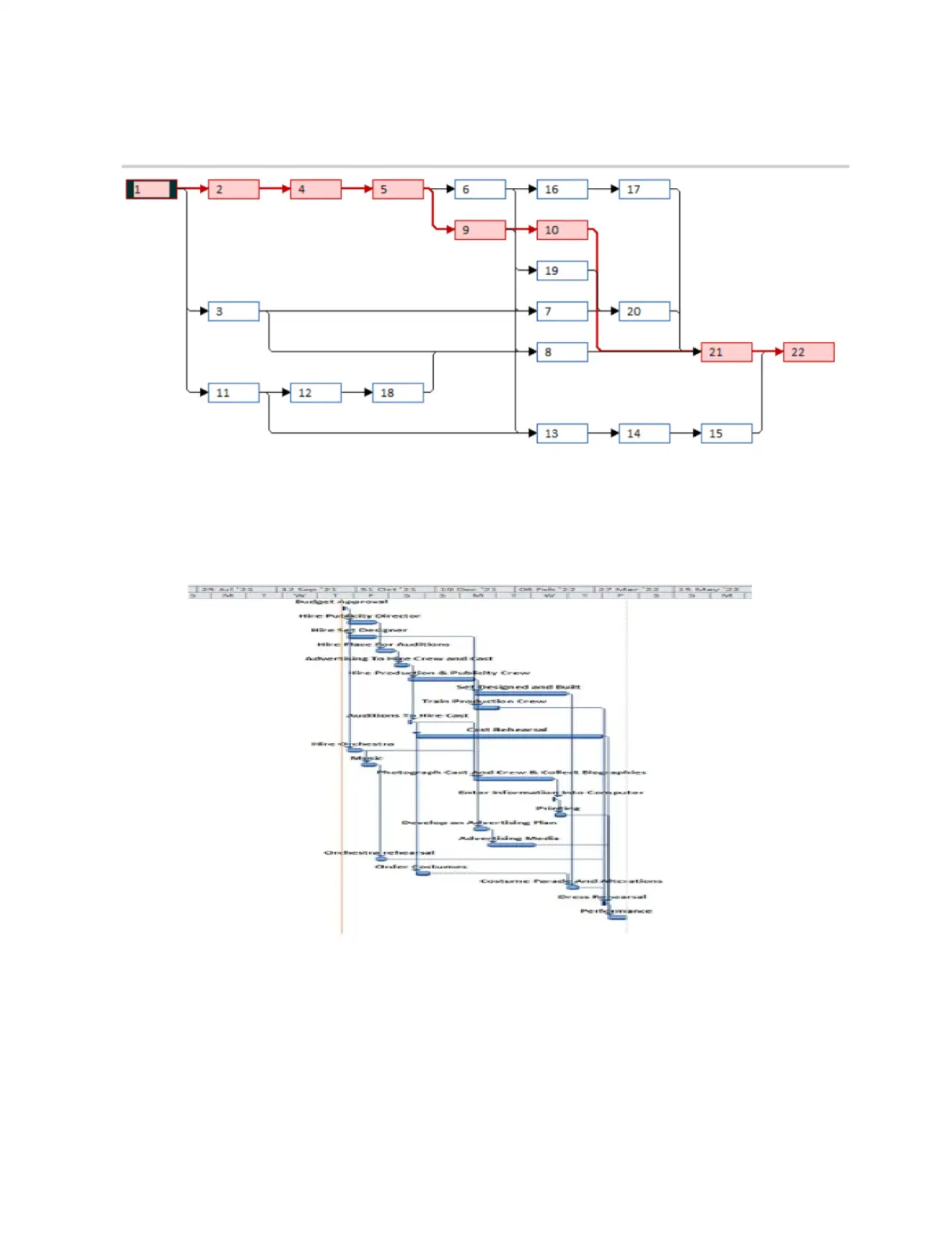
Paraphrase This Document
Need a fresh take? Get an instant paraphrase of this document with our AI Paraphraser

TASK 3
Stakeholder analysis
Stakeholder analysis refers to a procedure of collecting and analyzing qualitative data in a
systematic way in order to determine whose interests should be taken into consideration when
creating and implementing a policy (Fewings and Henjewele, 2019). In case of TFL, it is
important to conduct this analysis at the beginning of project to know which shareholder holds
the high interest and power.
High power high interest: In case of TFL, Town hall committee is considered who holds
high power and high interest. They develop rules and regulations to conduct the project.
High power low interest: For the current project, lenders and key advisors are considered
who holds high power but low interest to conduct the project. They can bring changes in
the project plan but get only certain amount of remuneration.
Low power high interest: In this analysis, analysts are considered for the current project
who gets data and make decisions accordingly (Kerzner, 2018).
Low power low interest: Customers and employees are divided in this stage as they
fulfilling their requirements and received salary respectively.
Stakeholder analysis
Stakeholder analysis refers to a procedure of collecting and analyzing qualitative data in a
systematic way in order to determine whose interests should be taken into consideration when
creating and implementing a policy (Fewings and Henjewele, 2019). In case of TFL, it is
important to conduct this analysis at the beginning of project to know which shareholder holds
the high interest and power.
High power high interest: In case of TFL, Town hall committee is considered who holds
high power and high interest. They develop rules and regulations to conduct the project.
High power low interest: For the current project, lenders and key advisors are considered
who holds high power but low interest to conduct the project. They can bring changes in
the project plan but get only certain amount of remuneration.
Low power high interest: In this analysis, analysts are considered for the current project
who gets data and make decisions accordingly (Kerzner, 2018).
Low power low interest: Customers and employees are divided in this stage as they
fulfilling their requirements and received salary respectively.
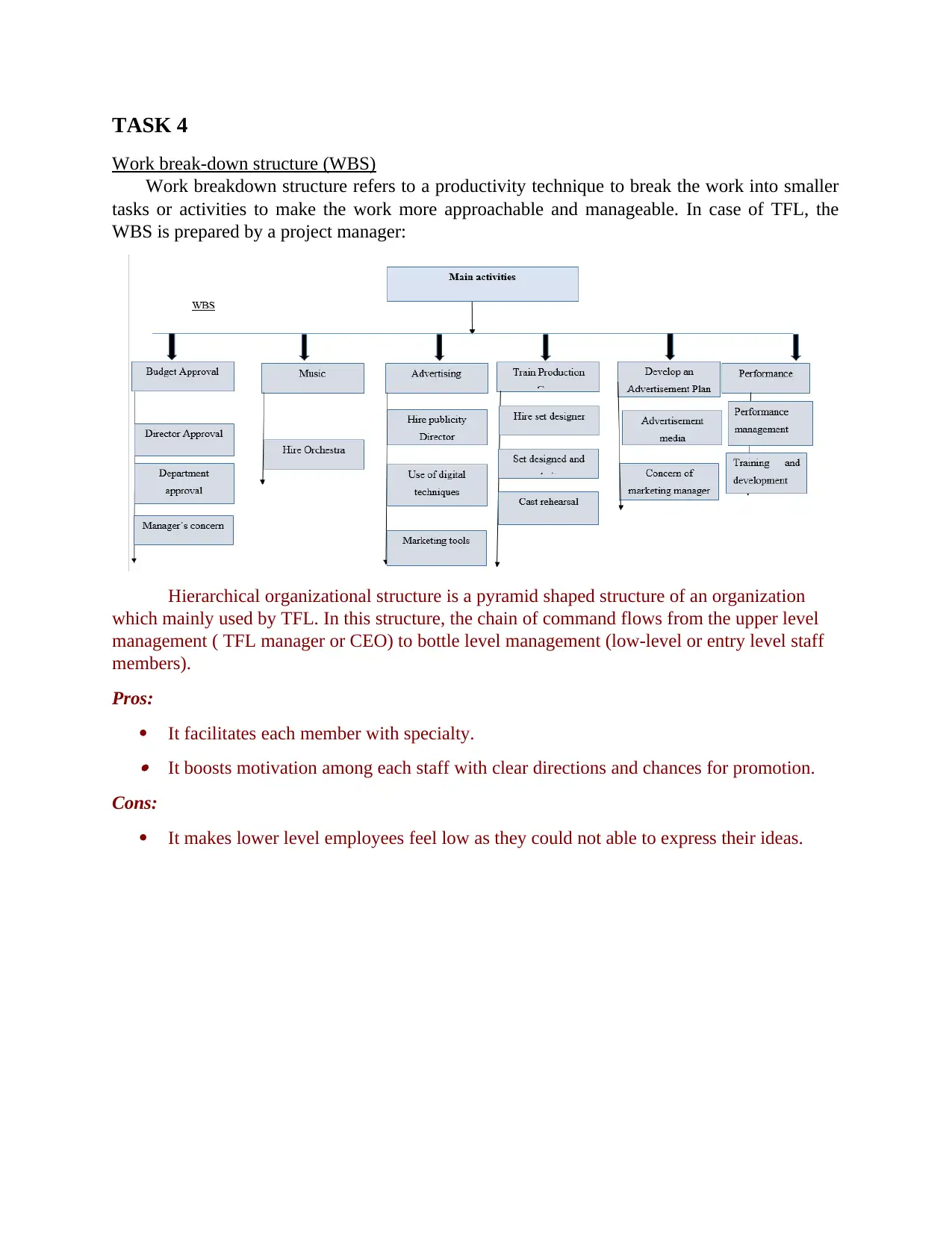
TASK 4
Work break-down structure (WBS)
Work breakdown structure refers to a productivity technique to break the work into smaller
tasks or activities to make the work more approachable and manageable. In case of TFL, the
WBS is prepared by a project manager:
Hierarchical organizational structure is a pyramid shaped structure of an organization
which mainly used by TFL. In this structure, the chain of command flows from the upper level
management ( TFL manager or CEO) to bottle level management (low-level or entry level staff
members).
Pros:
It facilitates each member with specialty. It boosts motivation among each staff with clear directions and chances for promotion.
Cons:
It makes lower level employees feel low as they could not able to express their ideas.
Work break-down structure (WBS)
Work breakdown structure refers to a productivity technique to break the work into smaller
tasks or activities to make the work more approachable and manageable. In case of TFL, the
WBS is prepared by a project manager:
Hierarchical organizational structure is a pyramid shaped structure of an organization
which mainly used by TFL. In this structure, the chain of command flows from the upper level
management ( TFL manager or CEO) to bottle level management (low-level or entry level staff
members).
Pros:
It facilitates each member with specialty. It boosts motivation among each staff with clear directions and chances for promotion.
Cons:
It makes lower level employees feel low as they could not able to express their ideas.
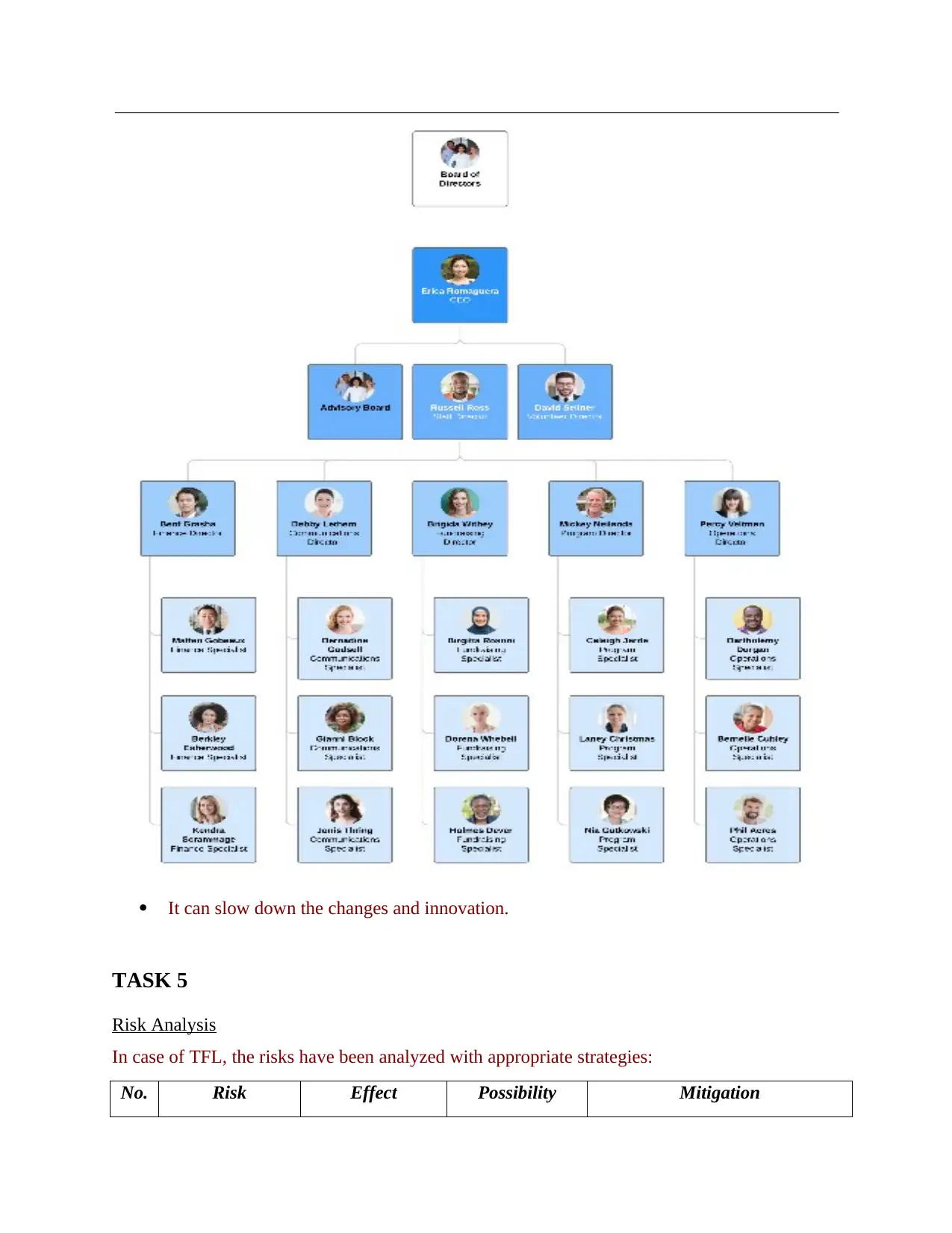
It can slow down the changes and innovation.
TASK 5
Risk Analysis
In case of TFL, the risks have been analyzed with appropriate strategies:
No. Risk Effect Possibility Mitigation
TASK 5
Risk Analysis
In case of TFL, the risks have been analyzed with appropriate strategies:
No. Risk Effect Possibility Mitigation
Secure Best Marks with AI Grader
Need help grading? Try our AI Grader for instant feedback on your assignments.

1 Failure of power Low High By using good quality raw
materials and machines, the risk
could be mitigated.
2 Safety and
security
Low Moderate By considering the data
protection act, workplace safety
as well as safety regulations, the
risk could be lessened.
3 Bad catering on
site
High Low In order to mitigate the risk,
hiring experienced and skilled
employees in catering will be
very supportive.
4 Changes in
Moderate
High Moderate The risk could be diminished by
formulating plans and estimating
previous weather (Sanchez,
Micaelli, Bonjour and
Monticolo, 2019).
5 Technological
updates
Low Moderate In order to complete the project
effectively, it is essential to
conduct market research and
launch upgraded technology,
6 Low Human
Resources
High High Choosing best employees and
handling work in a best way, the
risk could be controlled.
7 Lack of space Low High Proper management and
arrangement of all resources
could help to mitigate the risk.
8 Project conflicts High Low Getting right guidance and
supervision from leaders will
support in mitigation the risk.
9 Self-esteem High Low Taking opinions from others and
creating a good work culture will
help to mitigate the risk.
10 Issues
associated to
risks
High Low By acknowledging the society’s
issues and facilitating them with
right solutions, also participating
in CSR will also support in
mitigate the risk.
11 Lack of High Low By improving coordination and
materials and machines, the risk
could be mitigated.
2 Safety and
security
Low Moderate By considering the data
protection act, workplace safety
as well as safety regulations, the
risk could be lessened.
3 Bad catering on
site
High Low In order to mitigate the risk,
hiring experienced and skilled
employees in catering will be
very supportive.
4 Changes in
Moderate
High Moderate The risk could be diminished by
formulating plans and estimating
previous weather (Sanchez,
Micaelli, Bonjour and
Monticolo, 2019).
5 Technological
updates
Low Moderate In order to complete the project
effectively, it is essential to
conduct market research and
launch upgraded technology,
6 Low Human
Resources
High High Choosing best employees and
handling work in a best way, the
risk could be controlled.
7 Lack of space Low High Proper management and
arrangement of all resources
could help to mitigate the risk.
8 Project conflicts High Low Getting right guidance and
supervision from leaders will
support in mitigation the risk.
9 Self-esteem High Low Taking opinions from others and
creating a good work culture will
help to mitigate the risk.
10 Issues
associated to
risks
High Low By acknowledging the society’s
issues and facilitating them with
right solutions, also participating
in CSR will also support in
mitigate the risk.
11 Lack of High Low By improving coordination and

coordination channels of marketing could
help in mitigate the risk.
12 Lack of parking Low Low By constructing appropriate
space for parking will help in
reducing risk.
13 Low Morale Moderate Low By understanding workers’
issues and facilitating them with
benefits can help in boost morale
(Zwikael and Smyrk, 2019).
14 Government
influences
Low Low By abiding local laws and
regulations of government could
mitigate the risk.
15 Act of God Low High -
16 Improper time
management
Low High Prepare a schedule and then
implement activities.
17 Shortage of
resources
High Moderate To collect resources and
information from varieties of
sources
18 Market
uncertainties
High Low Understanding market
perspectives and managing
functions.
19 Employee
safety
High Low By facilitate disaster prevent
training as well as maintain
equality among staff members
help in risk mitigation.
20 Loss of finance Low Low Plan a budget and allocate
resources accordingly.
TASK 6
Partic
ulars
Quality
expectation
Acceptance criteria Quality specification Controlling
techniques
Adver
tising
Best Visitors upsurge by 25% Use of new technology
and digital marketing
Training and
management (Hasan
help in mitigate the risk.
12 Lack of parking Low Low By constructing appropriate
space for parking will help in
reducing risk.
13 Low Morale Moderate Low By understanding workers’
issues and facilitating them with
benefits can help in boost morale
(Zwikael and Smyrk, 2019).
14 Government
influences
Low Low By abiding local laws and
regulations of government could
mitigate the risk.
15 Act of God Low High -
16 Improper time
management
Low High Prepare a schedule and then
implement activities.
17 Shortage of
resources
High Moderate To collect resources and
information from varieties of
sources
18 Market
uncertainties
High Low Understanding market
perspectives and managing
functions.
19 Employee
safety
High Low By facilitate disaster prevent
training as well as maintain
equality among staff members
help in risk mitigation.
20 Loss of finance Low Low Plan a budget and allocate
resources accordingly.
TASK 6
Partic
ulars
Quality
expectation
Acceptance criteria Quality specification Controlling
techniques
Adver
tising
Best Visitors upsurge by 25% Use of new technology
and digital marketing
Training and
management (Hasan
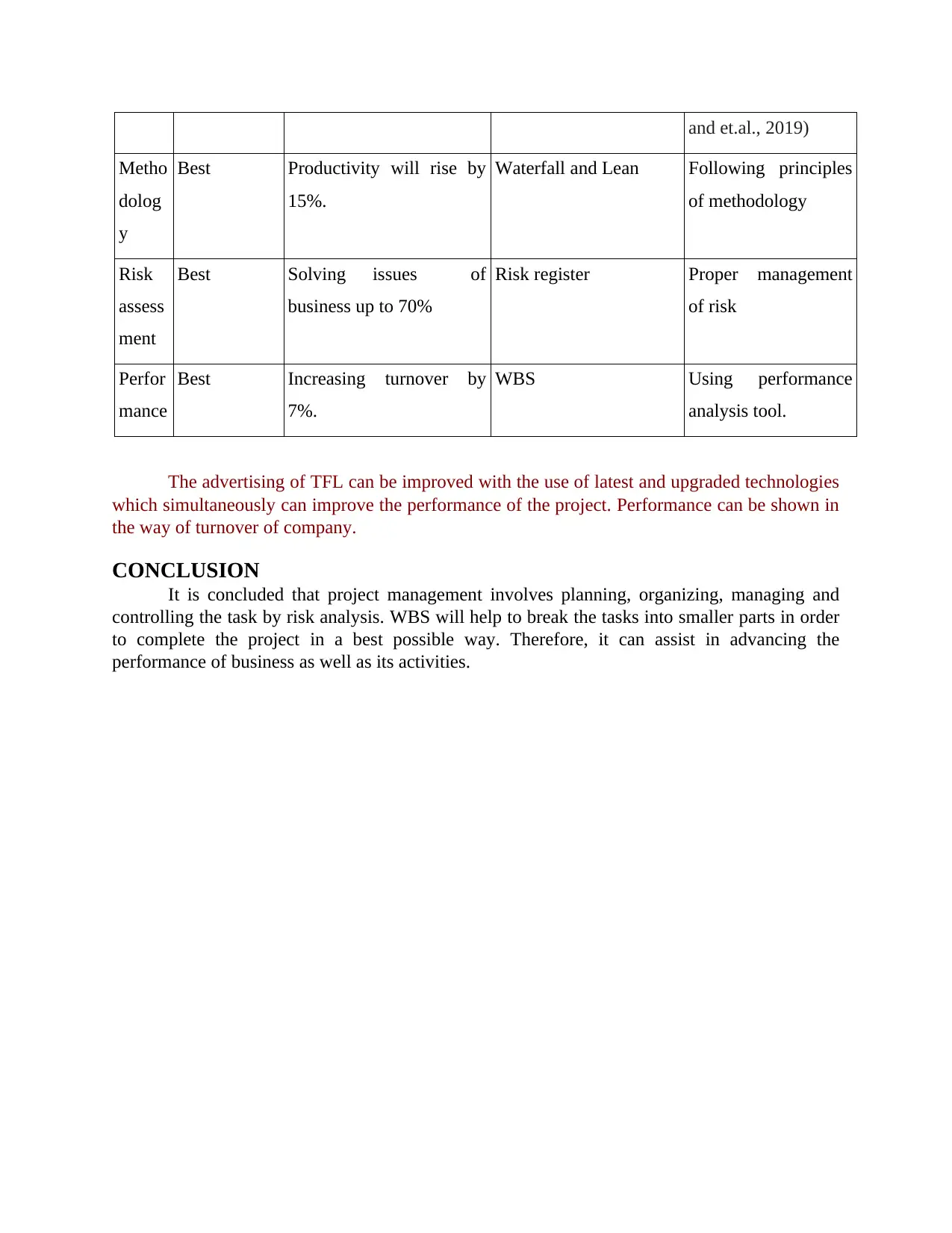
and et.al., 2019)
Metho
dolog
y
Best Productivity will rise by
15%.
Waterfall and Lean Following principles
of methodology
Risk
assess
ment
Best Solving issues of
business up to 70%
Risk register Proper management
of risk
Perfor
mance
Best Increasing turnover by
7%.
WBS Using performance
analysis tool.
The advertising of TFL can be improved with the use of latest and upgraded technologies
which simultaneously can improve the performance of the project. Performance can be shown in
the way of turnover of company.
CONCLUSION
It is concluded that project management involves planning, organizing, managing and
controlling the task by risk analysis. WBS will help to break the tasks into smaller parts in order
to complete the project in a best possible way. Therefore, it can assist in advancing the
performance of business as well as its activities.
Metho
dolog
y
Best Productivity will rise by
15%.
Waterfall and Lean Following principles
of methodology
Risk
assess
ment
Best Solving issues of
business up to 70%
Risk register Proper management
of risk
Perfor
mance
Best Increasing turnover by
7%.
WBS Using performance
analysis tool.
The advertising of TFL can be improved with the use of latest and upgraded technologies
which simultaneously can improve the performance of the project. Performance can be shown in
the way of turnover of company.
CONCLUSION
It is concluded that project management involves planning, organizing, managing and
controlling the task by risk analysis. WBS will help to break the tasks into smaller parts in order
to complete the project in a best possible way. Therefore, it can assist in advancing the
performance of business as well as its activities.
Paraphrase This Document
Need a fresh take? Get an instant paraphrase of this document with our AI Paraphraser
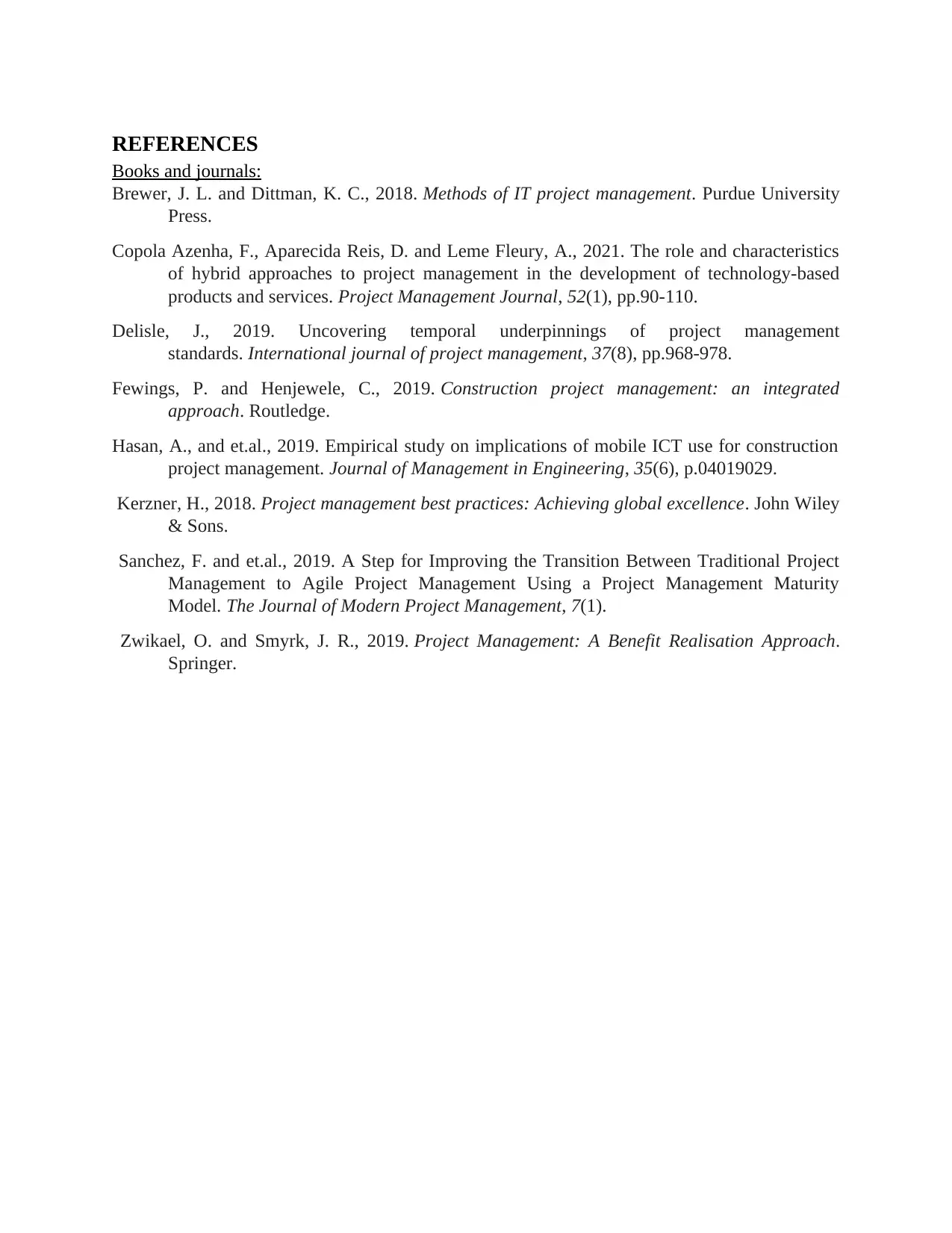
REFERENCES
Books and journals:
Brewer, J. L. and Dittman, K. C., 2018. Methods of IT project management. Purdue University
Press.
Copola Azenha, F., Aparecida Reis, D. and Leme Fleury, A., 2021. The role and characteristics
of hybrid approaches to project management in the development of technology-based
products and services. Project Management Journal, 52(1), pp.90-110.
Delisle, J., 2019. Uncovering temporal underpinnings of project management
standards. International journal of project management, 37(8), pp.968-978.
Fewings, P. and Henjewele, C., 2019. Construction project management: an integrated
approach. Routledge.
Hasan, A., and et.al., 2019. Empirical study on implications of mobile ICT use for construction
project management. Journal of Management in Engineering, 35(6), p.04019029.
Kerzner, H., 2018. Project management best practices: Achieving global excellence. John Wiley
& Sons.
Sanchez, F. and et.al., 2019. A Step for Improving the Transition Between Traditional Project
Management to Agile Project Management Using a Project Management Maturity
Model. The Journal of Modern Project Management, 7(1).
Zwikael, O. and Smyrk, J. R., 2019. Project Management: A Benefit Realisation Approach.
Springer.
Books and journals:
Brewer, J. L. and Dittman, K. C., 2018. Methods of IT project management. Purdue University
Press.
Copola Azenha, F., Aparecida Reis, D. and Leme Fleury, A., 2021. The role and characteristics
of hybrid approaches to project management in the development of technology-based
products and services. Project Management Journal, 52(1), pp.90-110.
Delisle, J., 2019. Uncovering temporal underpinnings of project management
standards. International journal of project management, 37(8), pp.968-978.
Fewings, P. and Henjewele, C., 2019. Construction project management: an integrated
approach. Routledge.
Hasan, A., and et.al., 2019. Empirical study on implications of mobile ICT use for construction
project management. Journal of Management in Engineering, 35(6), p.04019029.
Kerzner, H., 2018. Project management best practices: Achieving global excellence. John Wiley
& Sons.
Sanchez, F. and et.al., 2019. A Step for Improving the Transition Between Traditional Project
Management to Agile Project Management Using a Project Management Maturity
Model. The Journal of Modern Project Management, 7(1).
Zwikael, O. and Smyrk, J. R., 2019. Project Management: A Benefit Realisation Approach.
Springer.
1 out of 14
Related Documents
Your All-in-One AI-Powered Toolkit for Academic Success.
+13062052269
info@desklib.com
Available 24*7 on WhatsApp / Email
![[object Object]](/_next/static/media/star-bottom.7253800d.svg)
Unlock your academic potential
© 2024 | Zucol Services PVT LTD | All rights reserved.
